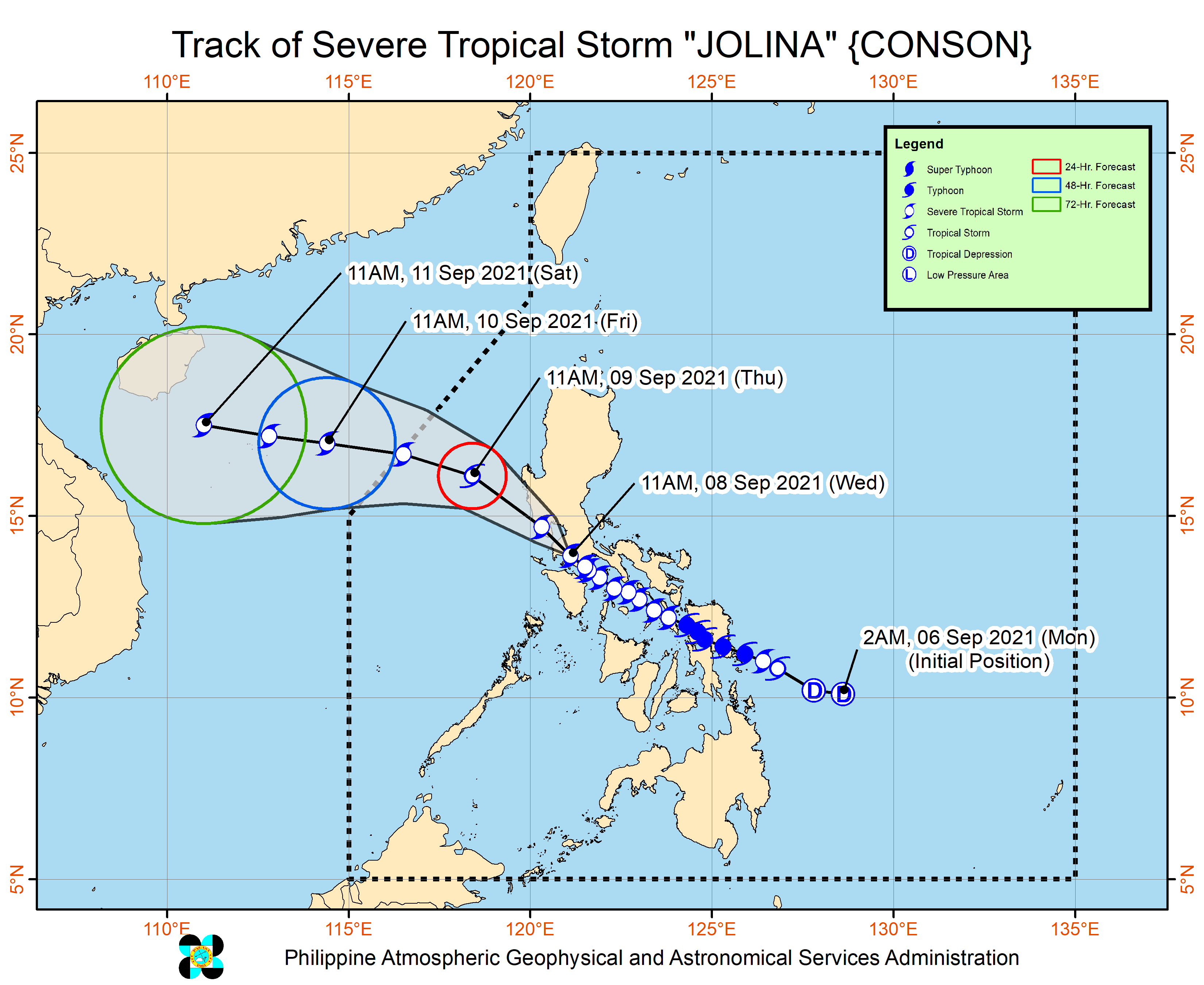SUMMARY
This is AI generated summarization, which may have errors. For context, always refer to the full article.

Severe Tropical Storm Jolina (Conson) was in the vicinity of San Nicolas, Batangas, early Wednesday afternoon, September 8, heading for the neighboring province of Cavite.
Jolina slightly accelerated, moving northwest toward Cavite at 15 kilometers per hour from the previous 10 km/h.
The severe tropical storm still has maximum sustained winds of 95 km/h, but its gustiness increased from 130 km/h to 160 km/h.
The Philippine Atmospheric, Geophysical, and Astronomical Services Administration (PAGASA) also warned in a bulletin released past 2 pm on Wednesday that Jolina will trigger more rain in the next 24 hours.
With no letup in the rain just yet, flood- and landslide-prone areas must stay on alert.
Heavy to intense rain, with at times torrential rain
- Metro Manila
- Bataan
- Cavite
- Laguna
- Batangas
- Rizal
- Quezon
- Occidental Mindoro
- Oriental Mindoro
Moderate to heavy rain, with at times intense rain
- Aurora
- Bulacan
- Nueva Ecija
- Pampanga
- Tarlac
- Zambales
- Camarines Sur
- Camarines Norte
- Romblon
- Marinduque
- northern part of Palawan including Calamian and Cuyo Islands
- Aklan
- Antique
- Capiz
- Iloilo
- Guimaras
- Negros Occidental
Light to moderate rain, with at times heavy rain
- Ilocos Region
- Cordillera Administrative Region
- Cagayan Valley
A few areas were removed from the list of places under tropical cyclone wind signals as of 2 pm on Wednesday, but two dozen others still need to watch out for winds brought by Jolina.
Signal No. 2 (damaging gale-force to storm-force winds)
- northern and central parts of Oriental Mindoro (Bansud, Gloria, Pinamalayan, Pola, Socorro, Victoria, Puerto Galera, San Teodoro, Baco, Calapan City, Naujan)
- northern and central parts of Occidental Mindoro (Abra de Ilog, Paluan, Mamburao, Santa Cruz, Sablayan) including Lubang Islands
- central part of Quezon (Infanta, Real, Mauban, Sampaloc, Lucban, Tayabas City, Lucena City, Sariaya, Candelaria, Dolores, Tiaong, San Antonio, Pagbilao)
- Batangas
- Cavite
- Laguna
- Rizal
- Metro Manila
- southern part of Bulacan (Pandi, Bulacan, Marilao, Calumpit, Norzagaray, Plaridel, Santa Maria, Balagtas, Bocaue, Bustos, Malolos City, Angat, Obando, San Jose del Monte City, Pulilan, Meycauayan City, Hagonoy, Paombong, Guiguinto, San Rafael, Baliuag)
- Pampanga
- Bataan
- Zambales
- Tarlac
Signal No. 1 (strong winds with occasional gusts)
- Marinduque
- La Union
- southern part of Benguet (Sablan, Tublay, Bokod, La Trinidad, Baguio City, Itogon, Tuba, Kapangan, Atok)
- southern part of Nueva Vizcaya (Alfonso Castañeda, Dupax del Norte, Dupax del Sur, Aritao, Santa Fe, Kayapa)
- southern part of Aurora (Baler, Maria Aurora, San Luis, Dingalan)
- Pangasinan
- Nueva Ecija
- rest of Bulacan
- northern and southern parts of Quezon (Padre Burgos, Agdangan, Unisan, Gumaca, Atimonan, Plaridel, Pitogo, Macalelon, Quezon, Alabat, Perez, General Nakar) including Polillo Islands
- rest of Oriental Mindoro
- rest of Occidental Mindoro
PAGASA again warned that storm surges up to 1 meter high could hit coastal areas of the following provinces in the next 24 hours:
- Oriental Mindoro
- Batangas
- Quezon
Storm surges may threaten life and property, warned the state weather bureau.
“In addition, coastal areas of localities under [tropical cyclone wind signals], especially those at No. 2, may also experience coastal flooding due to hazardous surf conditions,” PAGASA said.
Sea travel remains dangerous.
Rough to very rough seas (waves 2.5 to 5.5 meters high)
Travel risky for all vessels, inexperienced mariners should seek safe harbor
- seaboards of areas under Signal No. 2
Moderate to rough seas (waves 1.2 to 2.8 meters high)
Small vessels must take precautionary measures, inexperienced mariners should avoid navigation
- seaboards of areas under Signal No. 1
- remaining seaboards of Southern Luzon and Visayas
Jolina will cross Cavite on Wednesday afternoon, then emerge over Manila Bay either in the afternoon or evening.
Afterwards, it could make its ninth landfall in Bataan, also on Wednesday evening, then emerge over the West Philippine Sea by early Thursday morning, September 9.
So far, Jolina’s landfalls have been in these areas:
Monday, September 6 (as a typhoon)
- Hernani, Eastern Samar – 10 pm
Tuesday, September 7 (as a typhoon)
- Daram, Samar – 2 am
- Santo Niño, Samar – 3:40 am
- Almagro, Samar – 6:30 am
- Tagapul-an, Samar – 7:50 am
- Dimasalang, Masbate – 10 am
Wednesday, September 8 (as a severe tropical storm)
- Torrijos, Marinduque – 12:50 am
- San Juan, Batangas – 9 am
Following its movement over mainland Luzon, Jolina may weaken into a tropical storm. But it could intensify again over the West Philippine Sea beginning Thursday afternoon as it heads for the southern China-northern Vietnam area.
Jolina could exit the Philippine Area of Responsibility (PAR) on Thursday evening or early Friday morning, September 10. (READ: FAST FACTS: Tropical cyclones, rainfall advisories)

Meanwhile, Typhoon Kiko (Chanthu) was located 1,120 kilometers east of Central Luzon late Wednesday morning, not yet affecting the Philippines.
PAGASA will issue its next bulletin on Kiko at 5 pm on Wednesday.
Jolina and Kiko are the Philippines’ 10th and 11th tropical cyclones for 2021.
An average of 20 tropical cyclones form within or enter PAR each year. (READ: LIST: PAGASA’s names for tropical cyclones in 2021)
For the next six months, these are PAGASA’s estimates for the number of tropical cyclones inside PAR:
2021
- September – 2 or 3
- October – 2 or 3
- November – 2 or 3
- December – 1 or 2
2022
- January – 0 or 1
- February – 0 or 1
– Rappler.com
Add a comment
How does this make you feel?




There are no comments yet. Add your comment to start the conversation.